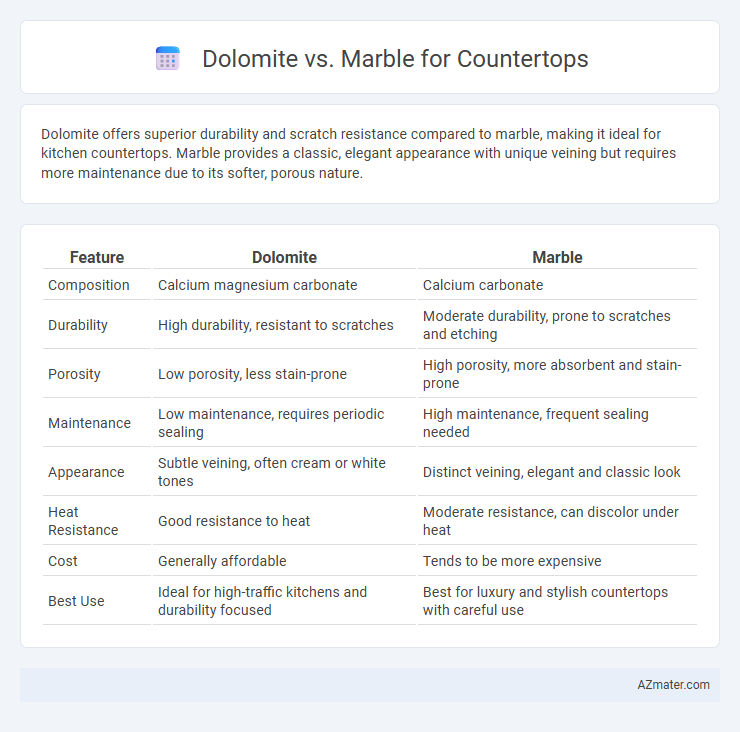Dolomite offers superior durability and scratch resistance compared to marble, making it ideal for kitchen countertops. Marble provides a classic, elegant appearance with unique veining but requires more maintenance due to its softer, porous nature.
Table of Comparison
| Feature | Dolomite | Marble |
|---|---|---|
| Composition | Calcium magnesium carbonate | Calcium carbonate |
| Durability | High durability, resistant to scratches | Moderate durability, prone to scratches and etching |
| Porosity | Low porosity, less stain-prone | High porosity, more absorbent and stain-prone |
| Maintenance | Low maintenance, requires periodic sealing | High maintenance, frequent sealing needed |
| Appearance | Subtle veining, often cream or white tones | Distinct veining, elegant and classic look |
| Heat Resistance | Good resistance to heat | Moderate resistance, can discolor under heat |
| Cost | Generally affordable | Tends to be more expensive |
| Best Use | Ideal for high-traffic kitchens and durability focused | Best for luxury and stylish countertops with careful use |
Understanding Dolomite and Marble: Key Differences
Dolomite is a calcium magnesium carbonate mineral known for its durability and resistance to acidic substances, making it a strong choice for countertops requiring longevity and minimal maintenance. Marble, primarily composed of calcite, is prized for its classic elegance and unique veining but is more porous and susceptible to etching and staining from acidic spills. Understanding these key differences in composition, hardness, and maintenance requirements aids in selecting the ideal material for kitchen countertops based on aesthetic preferences and functional needs.
Composition and Formation: Dolomite vs Marble
Dolomite is primarily composed of the mineral dolomite (calcium magnesium carbonate) formed through the alteration of limestone by magnesium-rich fluids, resulting in a harder and more chemically stable material. Marble is mainly composed of calcite (calcium carbonate) that forms through the metamorphism of limestone under high temperature and pressure, creating a crystalline and often more porous stone. The mineralogical differences affect durability, with dolomite generally offering superior resistance to etching and acids compared to marble.
Appearance and Aesthetic Appeal
Dolomite countertops offer a subtle, natural look with softer veining and a more muted color palette compared to marble, making them ideal for understated elegance in kitchens and bathrooms. Marble features dramatic, bold veining patterns and a wide range of hues, lending a timeless and luxurious aesthetic that enhances classic and contemporary spaces alike. The polished finish on both materials enhances their natural beauty, but marble tends to provide a higher-gloss, more reflective surface that amplifies its sophisticated appearance.
Durability and Hardness Comparison
Dolomite countertops exhibit superior durability and hardness compared to marble, with Mohs hardness ratings around 3.5 to 4.5, making them more resistant to scratches and etching. Marble, softer with a Mohs hardness of approximately 3, tends to be more prone to damage from daily use, including acid etching and staining. Due to its dense crystalline structure, dolomite offers enhanced resistance to wear and maintains its polished look longer under regular kitchen conditions.
Maintenance Requirements and Care Tips
Dolomite countertops require less maintenance than marble as they are naturally harder and more resistant to scratches and etching, making them ideal for kitchens with high usage. Marble demands frequent sealing and careful cleaning with pH-neutral products to prevent stains and damage from acidic substances, while dolomite needs resealing only periodically, typically once a year. Regular wiping with a soft cloth and avoiding harsh chemicals will prolong the lifespan of both stones, but dolomite offers a more forgiving surface that withstands everyday wear with minimal upkeep.
Stain and Scratch Resistance
Dolomite countertops exhibit higher stain resistance compared to marble due to their denser composition and lower porosity, making them less prone to absorbing spills and discoloration. In terms of scratch resistance, dolomite ranks superior as its hardness on the Mohs scale is generally around 3.5 to 4, whereas marble typically scores between 3 and 3.5, rendering marble more susceptible to surface scratches and etching. Homeowners prioritizing durability and maintenance ease often prefer dolomite for kitchens and bathrooms where staining and scratching are common concerns.
Cost and Affordability
Dolomite countertops typically cost less than marble, making them a more budget-friendly option for homeowners seeking natural stone surfaces. Marble varies widely in price but is generally more expensive due to its luxurious appearance and rarity, with costs ranging from $40 to $100 per square foot. Dolomite's affordability combined with its durability offers a cost-effective alternative without sacrificing the aesthetic appeal of natural stone countertops.
Popular Uses in Kitchen and Bathroom Countertops
Dolomite and marble are both popular choices for kitchen and bathroom countertops due to their natural elegance and durability. Dolomite offers superior resistance to scratches and heat, making it ideal for heavily used kitchen surfaces, while marble is favored for its classic aesthetic and unique veining, often used in bathroom countertops to create a luxurious look. Both materials require regular sealing to maintain their appearance and prevent staining in high-moisture environments.
Pros and Cons: Dolomite vs Marble
Dolomite countertops offer superior hardness and scratch resistance compared to marble, making them ideal for high-traffic kitchen surfaces, while marble is prized for its classic, elegant veining and softer, more porous texture that requires regular sealing. Dolomite's resistance to acids and etching outperforms marble, which can stain and etch easily when exposed to acidic substances like lemon juice or vinegar. However, marble provides a timeless aesthetic with a wider range of unique colors and patterns, whereas dolomite tends to have a more limited color palette and a slightly more uniform appearance.
Choosing the Right Material for Your Countertop
Dolomite offers superior durability and resistance to scratches and stains compared to marble, making it ideal for high-traffic kitchen countertops. Marble provides a classic, elegant appearance with unique veining patterns, but it requires more maintenance due to its porous nature and susceptibility to etching from acids. Selecting the right countertop material depends on balancing durability needs with aesthetic preferences and maintenance willingness.

Infographic: Dolomite vs Marble for Countertop
 azmater.com
azmater.com